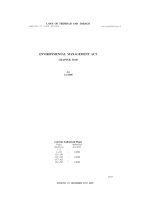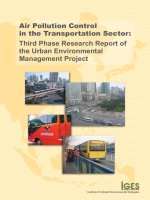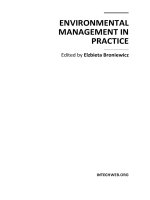Environmental management E363 lecture 3 water
Bạn đang xem bản rút gọn của tài liệu. Xem và tải ngay bản đầy đủ của tài liệu tại đây (65.09 KB, 13 trang )
E363 –
ENVIRONMENTAL MANAGEMENT
LECTURE 3 - WATER
Dr. Nguyen Thi Hoang Lien
WATER RESOURCES
• Water is an essential resource for all life on the planet.
• Of the water resources on earth: ~3% is not salty; twothirds of the freshwater is locked up in ice caps and
glaciers. Of the remaining one per cent, a fifth is in
remote, inaccessible areas and much seasonal rainfall
in monsoonal deluges and floods cannot easily be used.
• At present only about 0.08 per cent of all the world is
fresh water (Fry, C., 2008) is exploited by mankind in
ever
increasing
demand
for sanitation, drinking, manufacturing, leisure and agri
culture.
Fry, Carolyn: The Impact of Climate Change: The World’s Greatest Challenge in the
twenty-first century. 2008, Holland Publishers Ltd.
WATER CONSUMPTION
• Agriculture is the largest user of the world's freshwater
resources, consuming 70 per cent.
• Industry uses a further 20 per cent.
• Municipalities account for the remaining ten per cent.
• As the world's population rises and consumes more food
(currently exceeding 6%, it is expected to reach 9% by
2050), industries and urban developments expand, and the
emerging bio-fuel crops trade also demands a share of
freshwater resources, water scarcity is becoming an
important issue.
WATER POLLUTION
• Water pollution is the contamination of water bodies
(e.g. lakes, rivers, oceans and groundwater).
• Water pollution occurs when pollutants are discharged
directly or indirectly into water bodies without
adequate treatment to remove harmful compounds.
• Water pollution affects plants and organisms living in
these bodies of water. In almost all cases the effect is
damaging not only to individual species and
populations, but also to the natural biological
communities.
DISCHARGES
• Point sources water pollutions refers to contaminants that enter a
waterway from a single, identifiable source, such as
a pipe or ditch:
- Industrial
- Publicly owned water treatment works (POTWS)
• Non-point source pollution refers to diffuse contamination that
does not originate from a single discrete source. NPS pollution is
often the cumulative effect of small amounts of contaminants
gathered from a large area:
- Agricultural: CAFOs (concentrated agricultural feeding operation),
agricultural chemicals, etc.
- Urban: run-off
- Industrial: mining
WATER CONTAMINANTS
1. Organic water pollutants include:
• Detergents
• Disinfection by-products found in chemically disinfected drinking water, such
as chloroform
• Food processing waste, which can include oxygen-demanding substances, fats and
grease
• Insecticides and herbicides, a huge range of organohalides and other chemical
compounds
• Petroleum hydrocarbons, including fuels (gasoline, diesel fuel, jet fuels, and fuel oil)
and lubricants (motor oil), and fuel combustion byproducts, from stormwater runoff
• Tree and bush debris from logging operations
• Volatile organic compounds (VOCs), such as industrial solvents, from improper
storage.
• Chlorinated solvents, which are dense non-aqueous phase liquids (DNAPLs), may fall
to the bottom of reservoirs, since they don't mix well with water and are denser.
– Polychlorinated biphenyl (PCBs)
– Trichloroethylene
• Perchlorate
• Various chemical compounds found in personal hygiene and cosmetic products.
2. Inorganic water pollutants include:
• Acidity caused
by
industrial
discharges
(especially sulfure dioxide from power plants)
• Ammonia from food processing waste
• Chemical waste as industrial by-products
• Fertilizers containing
nutrients-nitrates and phosphate--which
are
found
in
stormwater runoff from agriculture, as well as
commercial and residential use
• Heavy metals from motor vehicles (via urban storm
runoff) and acid mine drainage
• Silt (sediment)
in
runoff
from construction sites, logging,
slash
and
burn practices or land clearing sites
LAW ON ENVIRONMENTAL
PROTECTION 2005
Chapter 7 – Section 2: Protection of river water
environment
Article 59.- Principles for river water environmental
protection
Article 60.- Control and treatment of the pollution of
the water environment in river basins
Article 61.- Responsibilities of provincial-level
People’s Committees for water environmental
protection in river basins
Article 62.- Organization of water environmental
protection in river basins
Chapter 7 – Section 3: Protection of the
environmental of other water sources
Article 63.- Protection of the environment of water
source in lakes, ponds, canals and ditches
Article 64.- Protection of the environment of
reservoirs used for irrigation and hydropower
purposes
Article 65.- Groundwater environment protection
Chapter 8 – Section 4: Management of waste water
Article 81.- Collection and treatment of waste water
Article 82.- Waste water treatment systems
NATIONAL TECHNICAL REGULATIONS
• QCVN 08:2008/BTNMT: National technical regulation on
surface water quality
• QCVN 09:2008/BTNMT: National technical regulation on
underground water quality
• QCVN 10:2008/BTNMT: National technical regulation on
coastal water quality
• QCVN 11:2008/BTNMT: National technical regulation on
the effluent of aquatic products processing industry
• QCVN 12:2008/BTNMT: National technical regulation on
the effluent of pulp and paper mills
• QCVN 13:2008/BTNMT: National technical regulation
the effluent of textile industry
• QCVN 14:2008/BTNMT: National technical regulation
domestic wastewater
• QCVN 24:2009/BTNMT: National technical regulation
industrial wastewater
• QCVN 25:2009/BTNMT: National technical regulation
wastewater of the solid waste landfill sites
• QCVN 01:2009/BYT: National technical regulation
drinking water quality
• QCVN 02:2009/BYT: National technical regulation
domestic water quality
on
on
on
on
on
on
• QCVN 28:2010/BTNMT: National technical regulation on
health care wastewater
• QCVN 29:2010/BTNMT: National technical regulation on
the effluent of petroleum terminal and stations
• QCVN 35:2010/BTNMT: National technical regulation on
discharged produced water for offshore oil and gas
facilities









